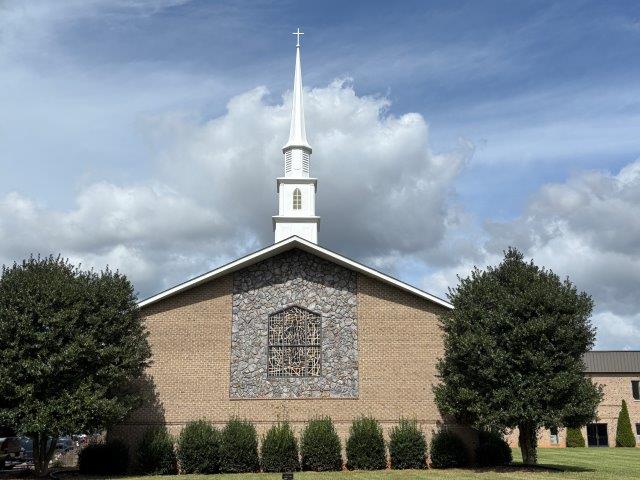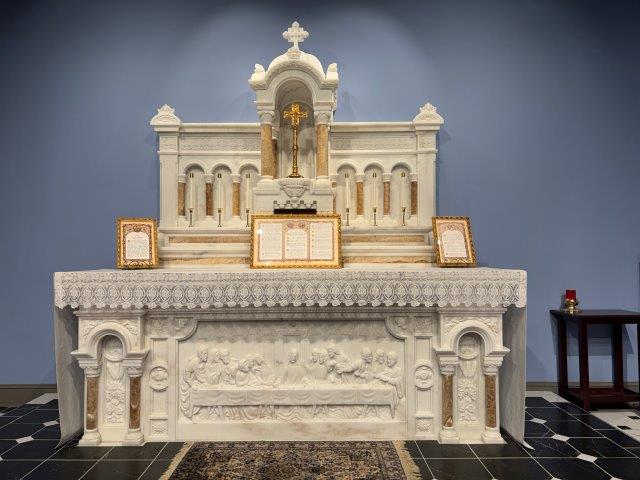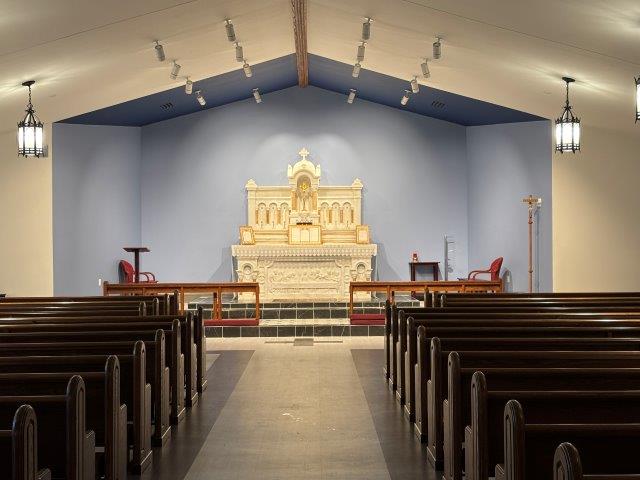Eighteenth Sunday after Pentecost
**Reminder: In the Diocese of Charlotte, Traditional Latin Masses are only offered at the Chapel of the Little Flower.
757 Oakridge Farm Highway, Mooresville, NC 28115
Sunday Latin Masses
10:00 a.m. (Low)
12:00 p.m.(Sung)
All other Latin Masses at the diocesan parishes have been discontinued. See schedule below.




Chapel of the Little Flower
Friends in Christ,
Welcome to our weekly Sunday update. This Sunday is the Eighteenth Sunday after Pentecost. In the Gospel reading for the day (Matthew 9:1-8), we are told that upon His arrival by boat at “His own city” Jesus was met by a group carrying “one sick of the palsy lying in bed.” Seeing the faith of those who brought the man, Our Lord immediately said to the paralytic, “Be of good heart, son, thy sins are forgiven thee.” Some scribes, hearing this, accused Him in their own thoughts of blasphemy; but Jesus, reading their minds, asked them, “Why do you think evil in your hearts?” Was it easier to tell a man his sins were forgiven or to say, “Arise and walk?” Then, having already forgiven the man’s sins, he demonstrated His power to accomplish the other as well, telling the man, “Arise, take up thy bed, and go into thy house.” The man having done so, “[T]he multitude seeing it feared and glorified God who had given such power to men.” Note that the people perceive the power—both to heal and to forgive sins—is given by God not just to a man but to men.
**Diocese of Charlotte Announces New Latin Mass Chapel**
The Diocese of Charlotte has announced the Chapel of the Little Flower, which is now the only location where the Traditional Latin Mass will be offered for the Diocese of Charlotte.
Chapel of the Little Flower
Mooresville, NC 28115
Sunday Latin Mass Times
- 10:00 a.m. (Low)
- 12 noon (Sung)
Holy Days: TBA
- Chaplain: Fr. Brandon Jones
- Website: https://charlottediocese.org/TLMChapel/
- More details: https://carolinaliturgy.org/chapel
- Diocesan Announcement: Chapel of the Little Flower to open for Traditional Latin Masses Oct. 5
We will share additional information about the chapel when announced by Father Jones and the diocese; and thank everyone for their patience as Father Jones begins his tenure as chaplain.
Saint Thérèse of the Child Jesus and the Holy Face, the Little Flower, pray for us!
Calendar of Special Observances
Celebrations are those listed in the Roman Missal of 1962.
DAY, DATE – FEAST (CLASS)
Sunday, October 12 – Eighteenth Sunday after Pentecost (II)
Monday, October 13 – St. Edward the Confessor, King (III)
Tuesday, October 14 – St. Callistus I, Pope and Martyr (III)
Wednesday, October 15 – St. Teresa of Avila, Virgin (III)
Thursday, October 16 – St. Hedwig, Widow (III)
Friday, October 17 – St. Margaret Mary Alocoque, Virgin (III)
Saturday, October 18 – St. Luke the Evangelist (II)
Eighteenth Sunday after Pentecost
The links provided below can be used to download printable copies of the Proper Prayers for the Eighteenth Sunday after Pentecost with either English or Spanish translation, followed by commentary by Dr. Michael P. Foley.
Latin Mass Schedule
Diocese of Charlotte Sunday Latin Masses
Chapel of the Little Flower (757 Oakridge Farm Road, Mooresville, NC)
- 10:00 a.m. (Low)
- 12:00 p.m. (Sung)
Note: Only Sunday Latin Masses and Holy Days will be offered at the Chapel. All other Sunday and daily Traditional Latin Masses at the other diocese of Charlotte parishes have been discontinued. These changes only affect Latin Masses in the diocese of Charlotte.
Diocese of Raleigh Sunday Latin Masses
- 1:00 p.m., Sacred Heart (Dunn, NC)
- 4:30 p.m. - First Sunday, Holy Name Cathedral (Raleigh, NC)
- For additional locations and Masses please see our Mass Times webpage
Diocese of Charleston Sunday Latin Masses
- 12:00 p.m., Prince of Peace (Taylors SC)
- 1:00 p.m., Our Lady of the Lake (Chapin SC)
Diocese of Charleston Daily Latin Masses
- Prince of Peace (Taylors SC) – Monday-Friday, 12:00 p.m.
- Prince of Peace (Taylors SC) – Saturday, 8:00 a.m.
- For additional locations and Masses please see our Mass Times webpage
Special Announcements
Gratias
The Carolina Traditional Liturgy Society wishes to express its gratitude and appreciation to Father Jones for offering the two inaugural Latin Masses at the Chapel of the Little Flower last Sunday (no easy feat). We also thank those who traveled to the chapel on its first weekend as well as those who remained at their parishes and supported their pastors and parishes. Thanks are also deserved for the diocesan staff and volunteers who helped prepare for the Chapel’s first weekend. If you haven’t attended yet, please consider visiting on a future Sunday.
Holy Hours for Our Chaplain, Father Jones
Seven Sisters Apostolate seeks to strengthen the Church by strengthening her priests. Their aim is to cover all priests with prayer by having groups of (at least) seven women each praying one Holy Hour one day of the week for a particular priest (a yearly renewable commitment). They are looking for coverage for Fr. Brandon Jones as he takes up this challenging task of pastoring the Chapel of the Little Flower. Any interested women interested in praying for Fr. Jones may contact Valerie Giggie for more information: SevenSistersCharlotte(at)gmail.com
Announcements
Support Our Parishes – Recently, Father Reid noted that Saint Ann parish will bear much of the financial costs of keeping the Chapel of the Little Flower open and encourages our continued generosity (and our occasional visits!). Parishioners from other parishes should continue to support their own parish.
533rd Anniversary of Columbus’ Discovery of the New World – Sunday October 12 is the Eighteenth Sunday after Pentecost, and it is also, historically, the 533rd anniversary of Christopher Columbus’ discovery of the New World. To celebrate, we share an excerpt of Pope Leo XIII’s 1892 encyclical, Quarto Abeunte Saeculo, commemorating the 400th anniversary of the discovery.
For Columbus is ours; since if a little consideration be given to the particular reason of his design in exploring the mare tenebrosum*, and also the manner in which he endeavoured to execute the design, it is indubitable that the Catholic faith was the strongest motive for the inception and prosecution of the design; so that for this reason also the whole human race owes not a little to the Church.
To read the entire encyclical click here. (* Mare tenebrosum is Latin for the Sea of Darkness, e.g. Atlantic Ocean)
**New Book** The Cassock: Sign of Christ, Sign of Contradiction, by Fr. Lawrence Carney (with Cardinal Burke’s Forward) – Slaying Dragons Press is releasing an excellent book on the cassock, authored by Fr. Lawrence Carney, the Holy Face priest (who visited St. Thomas Aquinas parish a few years ago). The Cassock: Sign of Christ, Sign of Contradiction examines the powerful witness of the cassock and its impact on both the priest and faithful. Slaying Dragons Press, is run by St. Thomas Aquinas parishioner and local writer Charles Fraune. To pre-order your copy, click here.
Daily Holy Face Chaplet for Sacred Liturgy (perpetual novena) –
For the preservation of the Traditional Latin Mass, it has been
recommended to all friends of the sacred liturgy in the diocese to
consider continually praying the powerful Holy Face chaplet, under the
banner of Our Lady of the Holy Name. To pray the chaplet, please see this link.
Cardinal Burke’s Prayer for Pope Leo XIV – His Eminence Cardinal Raymond Burke has released a prayer for Pope Leo XIV. Please see the prayer at the links below and consider praying this daily for the Holy Father as he leads the Church. PDF copies can be accessed at these links: [English] [Español] [Latin]
Holy Face Devotions
Prayers of Reparation to the Holy Face of Jesus are offered each week at the following churches on the indicated days:
- St. James (Concord) – Monday, 10-10:30 a.m. (in the cry room)
- St. Mark – Tuesday, 5:30 p.m.
- St. Thomas Aquinas – Tuesday, 6:00 a.m.
- St. Ann – Tuesday, 7:30 a.m. (following 7:00 a.m. Mass)
- St. Michael the Archangel (Gastonia) – Tuesday, 8:30 a.m. (following 8:00 a.m. Mass)
- St. Vincent de Paul – Tuesday, 8:40 a.m.
- Holy Spirit (Denver) – Tuesday, 10-11:00 a.m. (following the 9:15 a.m. Mass)
- Saint Elizabeth of the Hill Country (Boone) – Third Tuesday, at 6:45 p.m. after Mass in the Youth Room
- St. John the Baptist (Tryon) - First Saturday, 9:30 a.m. (after 8:30 a.m Mass)
- League of St. Martin Monthly Meeting in Gastonia – The League of St. Martin is a Holy Face apostolate that meets monthly to pray the Chaplet of the Holy Face of Jesus. For additional information regarding the League contact ericpieper@me.com for additional information.
- League of St. Martin Monthly Meeting in Clemmons – The League of St. Martin apostolate is meeting monthly at Holy Family Church in Clemmons to pray the Chaplet of the Holy Face of Jesus every 3rd Friday at 6:00 p.m. For additional information contact: amandamratledge@gmail.com or danielleparent@proton.me
Note: Days and times may be subject to change due to holidays.
“Jesus, Your ineffable image is the star which guides my steps. Ah, You know, Your sweet Face is for me Heaven on earth” (from Canticle to the Holy Face by Saint Thérèse de Lisieux, the 19th century Discalced Carmelite nun who took the name in religion, Thérèse of the Child Jesus and the Holy Face).
Latin Mass and Liturgical News
- Chapel of the Little Flower to open for Traditional Latin Masses Oct. 5 by Patricia Guilfoyle, Catholic News Herald (September 28, 2025). [Chapel of the Little Flower]
- The Fire of Faith: Guard the Flame (video), Our Lady of Clear Creek Abbey (October 1, 2025). [Fire of Faith]
- A Thriving Catholic Heartbeat in Nigeria (video), FSSP Mission Tradition (October 6, 2025). [Catholic Heartbeat in Nigeria]
- St. Peter and the Sea by Fr. William Rock, FSSP, The Missive (October 6, 2025). [St. Peter and the Sea]
- A Review of The Roman Canon and The Words of the Missal by Dr. Michael P. Foley, New Liturgical Movement (October 3, 2025). [The Roman Canon]
- 75 Years Later: Iconic ‘Jeep Mass’ Photo With Father Kapaun Still Inspires Hope by Jonah McKeown, National Catholic Register (October 7, 2025). [Jeep Mass Photo]
- Lepanto, the Poles, Islam, and Our Lady by Derya M. Little, Catholic World Report (October 7, 2024). [Lepanto]
- There's Something Fishy about that there Rosary by Fr. William Rock, FSSP, The Missive (October 7, 2024). [Something Fishy]
- Pope Leo urges Catholics to pray daily Rosary for Peace in October by Devin Watkins, Vatican News Service (September 24, 2025). [Rosary for Peace]
Saints and Special Observances
St. Teresa of Ávila was born on March 28, 1515, at Ávila in the Kingdom of Castile. Baptized Teresa Sánchez de Cepeda Dávila y Ahumada, she was the third of nine children born to her parents and ultimately one of twelve children in the family as her father also had three from a previous marriage. Her mother died when she was about fourteen, and Teresa sought solace in devotion to the Blessed Mother and distraction in reading the popular fiction of her day.
Having initially resisted the idea of a religious vocation, Teresa entered the Carmelite Convent of the Incarnation at the age of twenty. It was an institution not known for strict observance of the order’s rule. However, her reading of works on ascetical mysticism, such as the Tractatus de oratione et meditatione of St. Peter of Alcantara, led her down the more demanding path of self-mortification. The rigorous program of self-denial she pursued seriously impaired her health and nearly took her life, necessitating her removal from the convent. Confined to bed for almost a year before making a miraculous recovery she attributed to the intercession of Saint Joseph, she was absent from the convent for three years. When she returned, transformed by the mystical insights she had received during her illness, regarding the “prayer of quiet” and the “prayer of union,” she began to experience periods of spiritual ecstasy while engaged in prayer.
After reading a Spanish translation of St. Augustine’s Confessions, Teresa became convinced of the possibility of overcoming the effects of original sin in order to achieve a state of holiness. Nevertheless, the pleasure arising from social interaction with those around her impeded her spiritual progress for some time. It was only after she renounced such distractions and renewed her commitment to the life of prayer that she began to receive visions and hear voices that she believed came from God. Some around her came to believe she was the victim of hallucinations or even diabolically inspired delusions, but her Jesuit confessor, Fr. Francis Borgia, sought to reassure her that the things she saw and heard could only have a divine origin. When deeply immersed in a state of rapture, she was sometimes known to levitate; and she found it necessary to enjoin the other sisters in the convent not to hold her down on such occasions.
A visit by Peter of Alcantara in 1557 convinced the great mystic that Teresa was in the grip of the Holy Spirit. Commiserating with her over the slanders directed at her by those who doubted her visionary experiences, he urged her not to be diverted from the path of holiness. Teresa’s personal visions of Our Lord culminated in a mystical marriage to Christ in a ceremony that involved the repeated piercing of her heart by a fiery dart wielded by an angel so bright she took it to be a seraph.
Growing discontent with the laxity of conditions in the Convent of the Incarnation led Teresa to envision the establishment of a reformed Carmelite institution. In 1562 she opened a new convent dedicated to St. Joseph and was met with immediate opposition from both the prioress of the Incarnation and local authorities in the town. However, having obtained authorization for the new convent from the pope, as well as the concurrence of the local bishop, she was able to overcome efforts to stifle the reform movement before it got started. The nuns of St. Joseph embraced a rule of poverty and almost complete silence and, dressing in coarse habits with only sandals on their feet, came to be known as Discalced (or “shoeless”) Carmelites.
In 1567 Teresa founded a second convent at Medina del Campo. There followed, in quick succession, a third at Malagon, a fourth at Valladolid and a fifth at Toledo. At Medina del Campo she encountered two friars who, having heard of her reform, desired to adopt it: Antony de Heredia and John of the Cross. With their collaboration, and the permission of the prior general, she established a reformed Carmelite house for men at Durelo in 1569 and then a second at Pastrana. Her collaboration with John of the Cross, who was still in his twenties when they met, led to a lasting friendship. In time they became co-founders of the new Order of Discalced Carmelites.
Fr. Antony de Heredia was present to administer Extreme Unction just before Teresa died while on a visit to Alva de Tormez on the evening of October 4th in 1582. As it happened the new Gregorian calendar came into use the following day; and, as it required skipping ten days to get the seasons back into proper alignment, the date of her death was recorded as October 15th. That date eventually was proclaimed her feast day. She was buried in the place where she had died, according to her own expressed wish; but three years later the Reformed Carmelites secretly transferred her remains to Ávila. However, the Duke of Alva appealed to Rome and succeeded in securing the return of St. Teresa’s body to Alva de Tormez, where it has since remained.
While lacking the university training of her friend, John of the Cross, and writing only in the ordinary Castilian dialect of her native speech, St. Teresa produced numerous spiritual works of enduring value that are still essential elements of the Catholic literary canon after more than four hundred years. They include The Book of Life, The Way of Perfection, Interior Castle and The Book of Foundations. Her autobiography, The Life of Teresa of Jesus, stands with St. Augustine’s Confessions at the very summit of that genre. Her legacy also includes 31 poems and 458 extant letters. St. Teresa was beatified by Pope Paul V on April 24, 1614. She was canonized by Pope Gregory XV on March 12, 1622. On September 27, 1970, Pope Paul VI conferred the title, Doctor of the Church, on both St. Teresa and St. Catherine of Siena, the first women to be so honored.
Closing Commentary
We offer, in closing, an excerpt from the commentary of Dom Prosper Guéranger, OSB, on the “Eighteenth Sunday after Pentecost,” followed by a link to the full text of the commentary from The Liturgical Year.
Eighteenth Sunday after Pentecost
The Paralytic carrying his bed is the subject of this day’s Gospel, and gives the eighteenth Sunday after Pentecost its title. It has been thought, by some, that its having the number it bears has caused it to be inserted in the Missal immediately after the Ember Days of autumn. We will not, like the Liturgists of the Middle Ages, discuss the question as to whether we should consider it has having taken the place of the vacant Sunday, which formerly used always to follow the ordination of the sacred ministers, in the manner we have elsewhere described. Manuscript Sacramentaries and Lectionaries, of very ancient date, give it the name which was so much in use of Dominica vacat. Whatever may be the conclusion arrived at, there is one interesting point for consideration—that the Mass of this day is the only one in which is broken the order of the lessons taken from St. Paul, and which invariably form the subject of the Epistles, from the sixth Sunday after Pentecost: the Letter to the Ephesians—which we have had already before us, and will be afterwards continued—is today interrupted, and in its stead we have some verses from the first Epistle to the Corinthians, wherein the Apostle gives thanks to God for the manifold gratuitous gifts granted, in Christ Jesus, to the Church. Now, the powers conferred, by the imposition of the Bishop’s hands, on the ministers of the Church, are the most marvelous gift that is known on earth, yea, in heaven itself. The other portions of the Mass, too, are, as we shall see further on, most appropriate to the prerogatives of the new Priesthood. So that the Liturgy of the present Sunday is doubly telling, when it immediately follows the Ember Days of September. But this coincidence is far from being one of every year’s occurrence, at least as the Liturgy now stands; nor can we dwell longer on these subjects without seeming to be going too far into archæology, and exceeding the limits we have marked out for ourselves.
Mass.—The Introit of the Sunday Masses, since Pentecost, was always taken from the Psalms. From the 12th to the 118th, the Church, without ever changing the order of these sacred canticles, chose from each of them, as its own turn came, the Verses most appropriate to the Liturgy of each Sunday. But dating from today, she is going to select her Introits elsewhere, with one exception, however, when she will again turn to this the Book, by excellence, of divine praise. Her future opening-Anthems, for the Dominical Liturgy, to the end of the Year, will be taken from the various other books of the Old Testament. For this 18th Sunday, we have Jesus, son of Sirach, the inspired writer of Ecclesiastes, asking God to ratify, by the accomplishment of what they foretold, the fidelity of his Prophets. The interpreters of the divine oracles are now the Pastors whom the Church sends, in her own name, to preach the word of salvation and peace; let us, her children, pray with her, that their words may never be void.
The last Coming of the Son of Man is no longer far off! The approach of that final event, which is to put the Church in full possession of her divine Spouse, redoubles her hopes—but the Last Judgment, which is also to pronounce the eternal perdition of so great a number of her children, mingles fear with her desire; and these two sentiments of hers will henceforth be continually brought forward in the holy Liturgy. [Eighteenth Sunday after Pentecost]